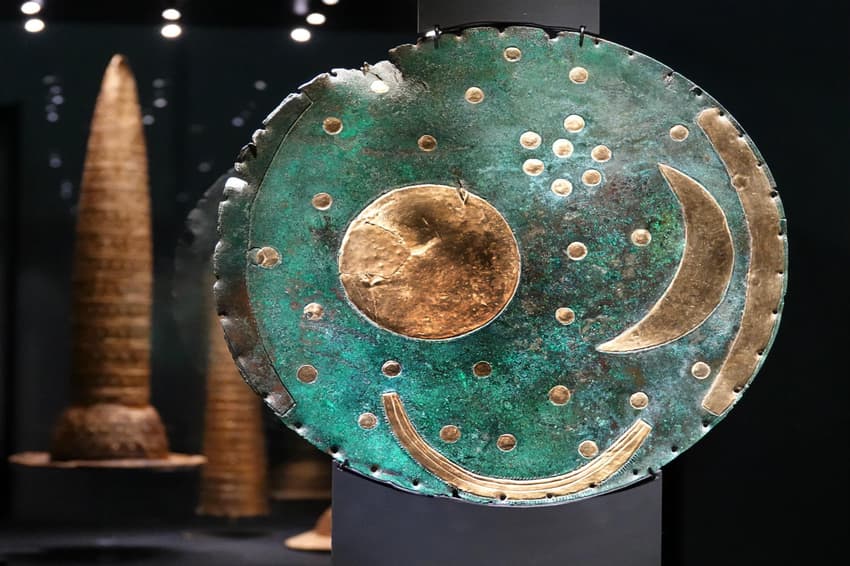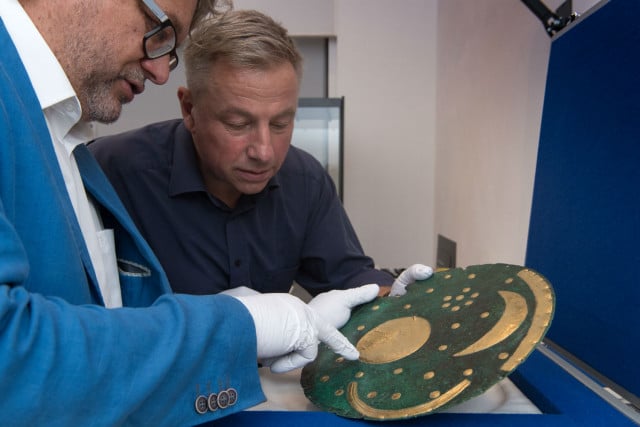What the mysterious 'Nebra Sky Disk' tells us about ancient German history

Twenty years ago, a stunning Bronze Age artifact was discovered in an eastern German forest. The subject of a new book, it reveals how people once saw the world - and the night sky above it.
Were it not for the treasure hunters, it might never have been found.
Buried in the woods near Nebra, in the eastern German state of Saxony-Anhalt, the artifact, along with jewellery and swords lay for over three thousand years, until the whine of metal detectors disturbed its silence one day in 1999.
Once uncovered, the Nebra Sky Disk would help us understand just how the ancestors of modern Germans viewed the world around them.
For now, however, this was all in the future.
Travelling through Europe
The Disk, considered just another ornamental adornment, was taken by the treasure hunters, Henry Westphal and Mario Renner, and found its way into the lucrative black market for archaeological artifacts, stretching across Europe.
There, the Disk, along with the artifacts uncovered with it, changed hands for two years until too many people became aware of it. Then, in a police sting worthy of Tatort, the treasures from Nebra were recovered and sent back to Saxony-Anhalt, to the care of Harald Meller, the state archaeologist.

Harald Meller (l), Saxony-Anhalt's state archeologist, and Matthias Wemhoff, Director of the Berlin Museum for Prehistory and Early History, take a look at the Nebra Sky Disk in the Martin-Gropius-Bau before it goes on display with 1,000 impressive artifacts found throughout Germany. Photo: DPA
That’s when Meller and his team discovered something extraordinary.
At first glance, the Disk - 30 cm in diameter and made of bronze, appeared to show the night sky, the moon and sun both present in gold. Two gold bands were also present - it appeared one had slipped from its original position.
Subsequent tests, however, that dated the deposition of the disk to around 1600 BCE and a manufacture date of 200 years before, revealed that the Bronze Age artifact was quite possibly much more than simple adornment.
When aligned properly and held flat, the gold bands aligned with the spread of sunrise and sunsets over the course of a year. The cluster of stars towards the top right appear to be the Pleiades constellation, possibly an aid in aligning the disk.
The Disk was also the subject of a recent Der Spiegel bestseller, co-authored by Kai Michel and the archaeologist who examined it, Harald Meller. The book is called ‘The Nebra Sky Disc: The Key to a Lost Culture in the Heart of Europe’, and while it is only available in German at present, an English edition with stunning illustrations is planned.
Unetice people: understanding the night sky
While the Unetice people, to whom it belonged, left no written records, the existence of the Disk does go a long way to supporting the idea that they had a complex understanding of the cycles of the night sky, and a developing understanding of navigation.
It is hypothesised that the Nebra Sky Disk was a ritual item, used by a priestly class at certain times of the year to remind and reaffirm the movements of the heavens, the path of sun and moon. This idea is supported by the provenance of the metals, that originate from all across Europe - this was no everyday item, and took a great deal of work to put together.
The Nebra Sky Disk is usually kept in the Landesmuseum für Vorgeschichte in Halle, but it sometimes lent out for exhibitions. It recently featured in the major exhibit of German archaeological artefacts, ‘Restless Times’, that brought thousands of visitors to Berlin.

The Nebra visitor centre in Saxony-Anhalt. Photo: DPA
For those who want to understand more about the world of the people who created the Nebra Sky Disk up close and personal, the ‘Nebra Ark’, a wonderfully-designed visitor centre, does a lot to interpret the world of the Bronze Age in an engaging, interactive fashion.
We may never know the exact use and provenance of the Nebra Sky Disk, but still it remains one of Germany’s most priceless archaeological treasures, and a reminder of the timeless relationship humanity has with the skies above.
GO EXPLORE
-
Landesmuseum für Vorgeschichte - Richard-Wagner-Straße 9, 06114 Halle (Saale)
-
The Nebra Ark - An der Steinklöbe 16, 06642 Nebra (Unstrut)
Mike Stuchbery, historian and author, contributes to The Local German on all things history.
Comments
See Also
Were it not for the treasure hunters, it might never have been found.
Buried in the woods near Nebra, in the eastern German state of Saxony-Anhalt, the artifact, along with jewellery and swords lay for over three thousand years, until the whine of metal detectors disturbed its silence one day in 1999.
Once uncovered, the Nebra Sky Disk would help us understand just how the ancestors of modern Germans viewed the world around them.
For now, however, this was all in the future.
Travelling through Europe
The Disk, considered just another ornamental adornment, was taken by the treasure hunters, Henry Westphal and Mario Renner, and found its way into the lucrative black market for archaeological artifacts, stretching across Europe.
There, the Disk, along with the artifacts uncovered with it, changed hands for two years until too many people became aware of it. Then, in a police sting worthy of Tatort, the treasures from Nebra were recovered and sent back to Saxony-Anhalt, to the care of Harald Meller, the state archaeologist.

Harald Meller (l), Saxony-Anhalt's state archeologist, and Matthias Wemhoff, Director of the Berlin Museum for Prehistory and Early History, take a look at the Nebra Sky Disk in the Martin-Gropius-Bau before it goes on display with 1,000 impressive artifacts found throughout Germany. Photo: DPA
That’s when Meller and his team discovered something extraordinary.
At first glance, the Disk - 30 cm in diameter and made of bronze, appeared to show the night sky, the moon and sun both present in gold. Two gold bands were also present - it appeared one had slipped from its original position.
Subsequent tests, however, that dated the deposition of the disk to around 1600 BCE and a manufacture date of 200 years before, revealed that the Bronze Age artifact was quite possibly much more than simple adornment.
When aligned properly and held flat, the gold bands aligned with the spread of sunrise and sunsets over the course of a year. The cluster of stars towards the top right appear to be the Pleiades constellation, possibly an aid in aligning the disk.
The Disk was also the subject of a recent Der Spiegel bestseller, co-authored by Kai Michel and the archaeologist who examined it, Harald Meller. The book is called ‘The Nebra Sky Disc: The Key to a Lost Culture in the Heart of Europe’, and while it is only available in German at present, an English edition with stunning illustrations is planned.
Unetice people: understanding the night sky
While the Unetice people, to whom it belonged, left no written records, the existence of the Disk does go a long way to supporting the idea that they had a complex understanding of the cycles of the night sky, and a developing understanding of navigation.
It is hypothesised that the Nebra Sky Disk was a ritual item, used by a priestly class at certain times of the year to remind and reaffirm the movements of the heavens, the path of sun and moon. This idea is supported by the provenance of the metals, that originate from all across Europe - this was no everyday item, and took a great deal of work to put together.
The Nebra Sky Disk is usually kept in the Landesmuseum für Vorgeschichte in Halle, but it sometimes lent out for exhibitions. It recently featured in the major exhibit of German archaeological artefacts, ‘Restless Times’, that brought thousands of visitors to Berlin.

The Nebra visitor centre in Saxony-Anhalt. Photo: DPA
For those who want to understand more about the world of the people who created the Nebra Sky Disk up close and personal, the ‘Nebra Ark’, a wonderfully-designed visitor centre, does a lot to interpret the world of the Bronze Age in an engaging, interactive fashion.
We may never know the exact use and provenance of the Nebra Sky Disk, but still it remains one of Germany’s most priceless archaeological treasures, and a reminder of the timeless relationship humanity has with the skies above.
GO EXPLORE
-
Landesmuseum für Vorgeschichte - Richard-Wagner-Straße 9, 06114 Halle (Saale)
-
The Nebra Ark - An der Steinklöbe 16, 06642 Nebra (Unstrut)
Mike Stuchbery, historian and author, contributes to The Local German on all things history.
Join the conversation in our comments section below. Share your own views and experience and if you have a question or suggestion for our journalists then email us at [email protected].
Please keep comments civil, constructive and on topic – and make sure to read our terms of use before getting involved.
Please log in here to leave a comment.